大连理工大学信息检索大作业-信息与通信工程学院-
- 格式:doc
- 大小:2.14 MB
- 文档页数:11
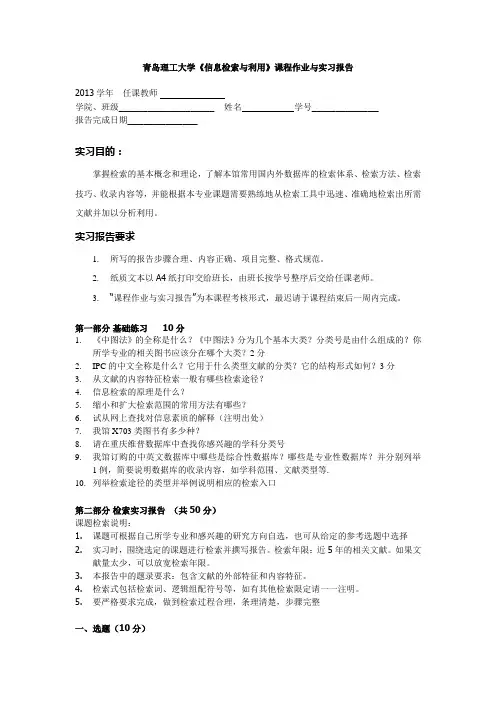
青岛理工大学《信息检索与利用》课程作业与实习报告2013学年任课教师学院、班级____________________ 姓名学号_____________报告完成日期_____________实习目的:掌握检索的基本概念和理论,了解本馆常用国内外数据库的检索体系、检索方法、检索技巧、收录内容等,并能根据本专业课题需要熟练地从检索工具中迅速、准确地检索出所需文献并加以分析利用。
实习报告要求1.所写的报告步骤合理、内容正确、项目完整、格式规范。
2.纸质文本以A4纸打印交给班长,由班长按学号整序后交给任课老师。
3.“课程作业与实习报告”为本课程考核形式,最迟请于课程结束后一周内完成。
第一部分基础练习10分1.《中图法》的全称是什么?《中图法》分为几个基本大类?分类号是由什么组成的?你所学专业的相关图书应该分在哪个大类?2分2.IPC的中文全称是什么?它用于什么类型文献的分类?它的结构形式如何?3分3.从文献的内容特征检索一般有哪些检索途径?4.信息检索的原理是什么?5.缩小和扩大检索范围的常用方法有哪些?6.试从网上查找对信息素质的解释(注明出处)7.我馆X703类图书有多少种?8.请在重庆维普数据库中查找你感兴趣的学科分类号9.我馆订购的中英文数据库中哪些是综合性数据库?哪些是专业性数据库?并分别列举1例,简要说明数据库的收录内容,如学科范围、文献类型等.10.列举检索途径的类型并举例说明相应的检索入口第二部分检索实习报告(共50分)课题检索说明:1.课题可根据自己所学专业和感兴趣的研究方向自选,也可从给定的参考选题中选择2.实习时,围绕选定的课题进行检索并撰写报告。
检索年限:近5年的相关文献。
如果文献量太少,可以放宽检索年限。
3.本报告中的题录要求:包含文献的外部特征和内容特征。
4.检索式包括检索词、逻辑组配符号等,如有其他检索限定请一一注明。
5.要严格要求完成,做到检索过程合理,条理清楚,步骤完整一、选题(10分)1.检索课题名称中文:___________________________________________英文:____________________________________________2.关键词或主题词(中、英文):___________________________________________3.检索式中文:___________________________________________英文:____________________________________________二、根据课题所属学科,检索中文图书和期刊数据库。
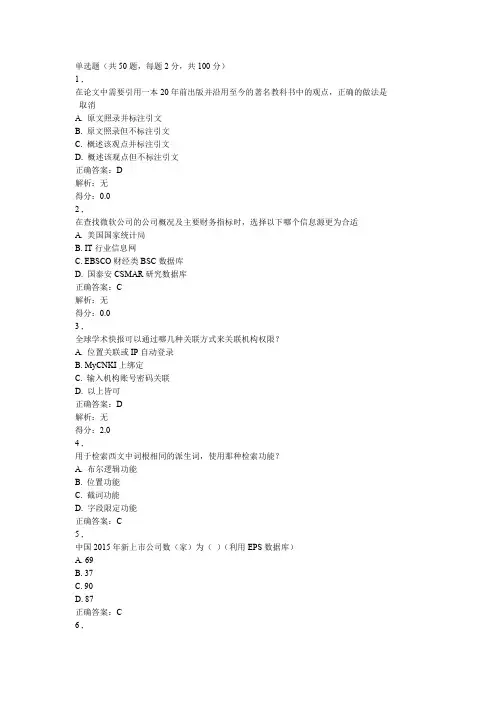
单选题(共50题,每题2分,共100分)1 ,在论文中需要引用一本20年前出版并沿用至今的著名教科书中的观点,正确的做法是取消A. 原文照录并标注引文B. 原文照录但不标注引文C. 概述该观点并标注引文D. 概述该观点但不标注引文正确答案:D解析:无得分:0.02 ,在查找微软公司的公司概况及主要财务指标时,选择以下哪个信息源更为合适A. 美国国家统计局B. IT行业信息网C. EBSCO财经类BSC数据库D. 国泰安CSMAR研究数据库正确答案:C解析:无得分:0.03 ,全球学术快报可以通过哪几种关联方式来关联机构权限?A. 位置关联或IP自动登录B. MyCNKI上绑定C. 输入机构账号密码关联D. 以上皆可正确答案:D解析:无得分:2.04 ,用于检索西文中词根相同的派生词,使用那种检索功能?A. 布尔逻辑功能B. 位置功能C. 截词功能D. 字段限定功能正确答案:C5 ,中国2015年新上市公司数(家)为()(利用EPS数据库)A. 69B. 37C. 90D. 87正确答案:C6 ,汇集年度重要信息,逐年编辑、连续出版的工具书是A. 史事年表B. 文摘C. 手册D. 年鉴正确答案:D7 ,下列哪一项不是知网资源收录原则?A. 完整性B. 合法出版原则C. 作者权威性D. 著作权使用许可正确答案:C8 ,主题语言中,最早出现的一种类型是A. 叙词B. 关键词C. 标题词D. 元词正确答案:C9 ,下列哪项不属于分组浏览A. 研究层次B. 机构C. 基金D. 关键字正确答案:D10 ,改革开放以来,随着中国经济的发展、观念的改变,涉外婚姻开始兴起。
据统计,2015年中国涉外登记婚姻超过4万对,是1979年的5倍(数据来源:EPS数据平台)。
2015年,涉外登记婚姻(不含港澳台及华侨)占当年本地登记结婚比例最高的是哪个省A. 云南省B. 上海市C. 福建省D. 北京市正确答案:B11 ,利用中国知网(CNKI)-博硕士学位论文库,在关键词字段中检索“自由贸易区”,满足条件的博硕士学位论文中,被引率最高的论文的授予单位是:A. 大连工业大学B. 天津理工大学C. 大连理工大学D. 天津财经大学正确答案:C12 ,每晚黄金时间聚在一起观看电视剧,已成为不少家庭的温馨时刻或美好回忆。


信息检索课作业姓名学号院系环境学院专业环境工程三、文献检索范围及结果(请附上检索结果截图)1.《中国学术期刊网络出版总库》(CNKI中国知网)(1)第一步检索,用专业检索,构建检索式FT=('零价铁'+'ZVI'+'Fe'+'Fe0')*('硝基苯'+’NB’)*'废水'*'厌氧'*('降解'+'处理'+'治理'),检索到3820条信息,检索结果过多。
(2)考虑从全文范围内搜索改为主题搜索,搜索结果为20条。
(3)扩大检索范围,删掉检索式中相对不重要的词'废水'和('降解'+'处理'+'治理'),检索出文献32条。
(4)检索结果,最终检索式为SU=('零价铁'+'ZVI'+'Fe'+'Fe0')*('硝基苯'+’NB’)*'厌氧'[1].叶敏,徐向阳,谢雨生. 氯代硝基苯类生产废水厌氧-好氧序列生物处理研究Ⅱ.铁碳还原-A/ O组合工艺性能[J]. 浙江大学学报(农业与生命科学版),2003,02:86-91.[2]董玲玲,吴锦华,吴海珍,吴超飞,韦朝海. 硝基苯厌氧降解过程中Fe~0的促进作用[J]. 环境化学,2005,06:14-17.[3]陈皓,陈玲,赵建夫,张红,孙娜. 铁元素对有机物厌氧降解的影响研究[J]. 四川环境,2005,06:14-16.[4]吴锦华,韦朝海,李平. 金属离子及盐度对硝基苯厌氧生物降解过程的影响[J]. 环境科学研究,2009,01:99-102.[5]罗春香,戴友芝,史雷,李双双. Fe~0/厌氧微生物联合体系降解硝基苯的研究[J]. 微生物学通报,2009,02:160-164.[6]罗春香,戴友芝,李启武,史雷,汤文琪. 不同还原环境下Fe~0/厌氧微生物联合体系降解硝基苯的研究[J]. 水处理技术,2009,04:31-34.[7]陈玲,刘强,陈皓,赵建夫. 不同价态铁对硝基苯的厌氧降解及影响因素[J]. 同济大学学报(自然科学版),2009,04:510-514.[8]王煜乾,李胜,何媛君. 铁炭还原法预处理难降解有机化工废水[J]. 应用化工,2009,07:1049-1051+1055.[9]陈前. HABR-SBR联合处理硝基苯废水的研究[D].南京理工大学,2009.[10]贾玉红. 菌株Dyella -4降解底物广谱性及其在土壤修复中的应用[D].大连理工大学,2009.[11]罗春香. 零价铁/厌氧微生物联合体系降解硝基苯及机理[D].湘潭大学,2009.[12]查清云. 氯代硝基苯污染地下水的生物修复过程[D].华南理工大学,2011.[13]董玲玲,吴锦华,韦朝海,李平,吴超飞. 厌氧条件下Fe~0-菌体-H_2O体系对硝基苯的降解[A]. 中国化学会、上海交通大学.第二届全国环境化学学术报告会论文集[C].中国化学会、上海交通大学:,2004:4. [14]董玲玲,吴锦华,吴海珍,吴超飞,韦朝海. 硝基苯厌氧降解过程中Fe~0的促进作用[A]. .中国环境保护优秀论文精选[C].:,2006:5.[15]刘川. 零价铁/磁/厌氧微生物联合体系降解硝基苯废水的研究[D].湘潭大学,2011.[16]杨娟,任源,肖凯军,韦朝海. 混凝-Fenton氧化-Fe~0还原预处理高浓度硝基苯生产废水[J]. 环境工程学报,2012,05:1483-1488.[17]赵勇胜,马百文,杨玲,刘莹莹,刘鹏,李敬杰,孙威. 纳米铁还原高浓度硝基苯的实验[J]. 吉林大学学报(地球科学版),2012,S1:386-391.[18]梁俊倩,吴锦华,李平,王向德,杨波. 零价铁与厌氧微生物协同还原地下水中的硝基苯[J]. 环境工程学报,2012,08:2512-2516.[19]叶敏. 氯代硝基苯类生产废水处理工艺技术研究及其工业化应用[D].浙江大学,2002.[20]郑昱. 含氯含硝基芳烃类污染物ZVI还原转化及QSAR的研究[D].浙江大学,2005.[21]项硕. 氯代硝基苯污染物厌氧—好氧序列生物降解的研究[D].浙江大学,2003.[22]蔡哲锋. 催化臭氧化处理难降解制药废水研究[D].浙江大学,2004.[23]林海转. 零价铁与微生物耦合强化含氯含硝基芳烃类污染物转化和降解研究[D].浙江大学,2011.[24]孙威. 地下水中苯类有机污染的原位反应带修复技术研究[D].吉林大学,2012.[25]梁俊倩. 硝基苯污染地下水的零价铁与生物修复[D].华南理工大学,2012.[26]杨娟. 硝基苯废水物化—生物处理及菌群结构分析[D].华南理工大学,2012.[27]林海转,徐向阳,朱亮,戚姣琴. 零价铁与厌氧微生物协同降解氯代硝基苯的特性研究[A]. 中国化学会环境化学专业委员会、中国环境科学学会环境化学分会、中国毒理学会分析毒理专业委员会.第六届全国环境化学大会暨环境科学仪器与分析仪器展览会摘要集[C].中国化学会环境化学专业委员会、中国环境科学学会环境化学分会、中国毒理学会分析毒理专业委员会:,2011:1.[28]郑昱,徐向阳,蔡文祥,朱亮. ZVI还原转化硝基芳烃特性及QSAR的研究[J]. 浙江大学学报(农业与生命科学版),2006,01:31-35.[29]郭冀峰,陈花果,夏四清,逯延军. 难降解有机化工废水处理中试试验[J]. 工业水处理,2007,02:17-19.[30]朱宜平,张海平,张键. 高浓度硝基苯类生产废水物化-生化处理试验研究[J]. 环境工程,2008,03:35-38+3.[31]安立超. 含硝基苯类化合物工业废水生物降解及处理技术研究[D].南京理工大学,2003.[32]安永磊. 原位生物修复硝基苯污染地下水微生物群落结构及修复效能[D].吉林大学,2012.2.《数字化期刊全文数据库》(万方数据)(1)输入检索式:主题:(零价铁+ZVI+Fe+Fe0)*厌氧*(硝基苯+NB)*废水*(降解+处理+治理),检索结果为13条,检索结果相对过少。
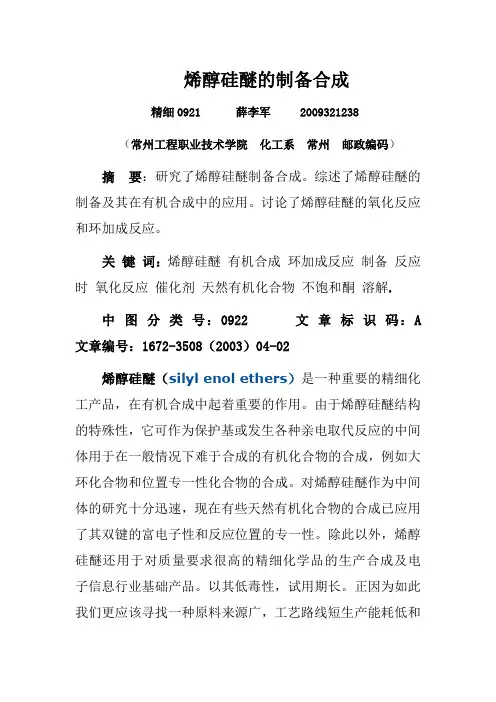
烯醇硅醚的制备合成精细0921 薛李军 2009321238(常州工程职业技术学院化工系常州邮政编码)摘要:研究了烯醇硅醚制备合成。
综述了烯醇硅醚的制备及其在有机合成中的应用。
讨论了烯醇硅醚的氧化反应和环加成反应。
关键词:烯醇硅醚有机合成环加成反应制备反应时氧化反应催化剂天然有机化合物不饱和酮溶解.中图分类号:0922 文章标识码:A 文章编号:1672-3508(2003)04-02烯醇硅醚(silyl enol ethers)是一种重要的精细化工产品,在有机合成中起着重要的作用。
由于烯醇硅醚结构的特殊性,它可作为保护基或发生各种亲电取代反应的中间体用于在一般情况下难于合成的有机化合物的合成,例如大环化合物和位置专一性化合物的合成。
对烯醇硅醚作为中间体的研究十分迅速,现在有些天然有机化合物的合成已应用了其双键的富电子性和反应位置的专一性。
除此以外,烯醇硅醚还用于对质量要求很高的精细化学品的生产合成及电子信息行业基础产品。
以其低毒性,试用期长。
正因为如此我们更应该寻找一种原料来源广,工艺路线短生产能耗低和生产成本低,毒性污染小的方法来合成烯醇硅醚,已达到最好的经济效益。
实验部分烯醇硅醚制备方法很多,现在就其主要合成方法做一些介绍。
1.由硅烷基酮制备β-三甲基硅烷酮很容易发生重排反应生成三甲硅烷基烯醇醚这个反应一般都是用Lewis酸或碘化汞作催化剂。
α-硅烷基酮发生的Brook 重排也可用于稀醇硅醚的制备。
另外,Wittig试剂与硅烷基酮反应同样可得到烯醇硅醚样可得到烯醇硅醚。
乙烯基负离子与α-硅烷基酮发生亲核加成反应, 再发生Brook重排, 得到的产物是顺式三甲硅烷基烯醇醚.2.由氢化硅烷与酮反应制备氢化硅烷在催化剂(如Co(CO)8[Ph3P]3RhCl等)存在下与酮反应可制得烯醇硅醚。
α,β-不饱和毅基化合物与氢化硅烷发生1,4-一硅氢化反应生成烯醇硅醚。
1,2-和1,4-硅氢化产物的产率随氢化硅烷的不同而不同。
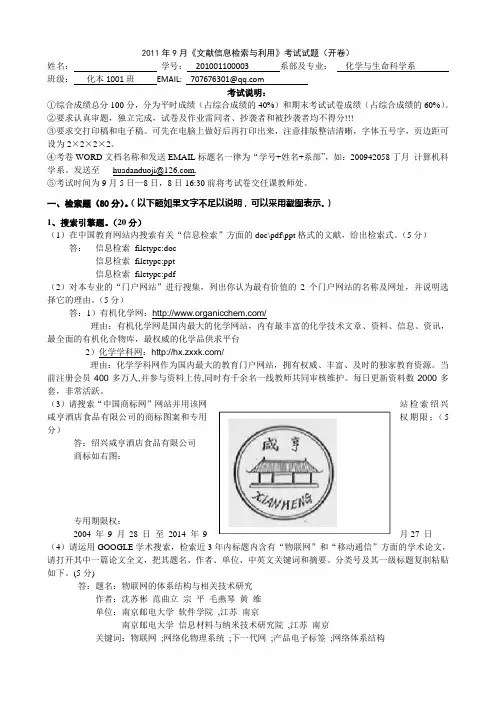
考试说明:①综合成绩总分100分,分为平时成绩(占综合成绩的40%)和期末考试试卷成绩(占综合成绩的60%)。
②要求认真审题,独立完成,试卷及作业雷同者、抄袭者和被抄袭者均不得分!!!③要求交打印稿和电子稿。
可先在电脑上做好后再打印出来,注意排版整洁清晰,字体五号字,页边距可设为2×2×2×2。
④考卷WORD文档名称和发送EMAIL标题名一律为“学号+姓名+系部”,如:200942058丁月_计算机科学系。
发送至huadanduoji@.⑤考试时间为9月5日—8日,8日16:30前将考试卷交任课教师处。
一、检索题(80分)。
(以下题如果文字不足以说明,可以采用截图表示。
)1、搜索引擎题。
(20分)(1)在中国教育网站内搜索有关“信息检索”方面的doc\pdf\ppt格式的文献,给出检索式。
(5分)答:信息检索filetype:doc信息检索filetype:ppt信息检索filetype:pdf(2)对本专业的“门户网站”进行搜集,列出你认为最有价值的2个门户网站的名称及网址,并说明选择它的理由。
(5分)答:1)有机化学网:/理由:有机化学网是国内最大的化学网站,内有最丰富的化学技术文章、资料、信息、资讯,最全面的有机化合物库,最权威的化学品供求平台2)化学学科网:/理由:化学学科网作为国内最大的教育门户网站,拥有权威、丰富、及时的独家教育资源。
当前注册会员400多万人,并参与资料上传,同时有千余名一线教师共同审核维护。
每日更新资料数2000多套,非常活跃。
(3)请搜索“中国商标网”网站并用该网站检索绍兴咸亨酒店食品有限公司的商标图案和专用权期限;(5分)答:绍兴咸亨酒店食品有限公司商标如右图:专用期限权:2004 年9 月28 日至2014 年9 月27 日(4)请运用GOOGLE学术搜索,检索近3年内标题内含有“物联网”和“移动通信”方面的学术论文,请打开其中一篇论文全文,把其题名、作者、单位、中英文关键词和摘要、分类号及其一级标题复制粘贴如下。
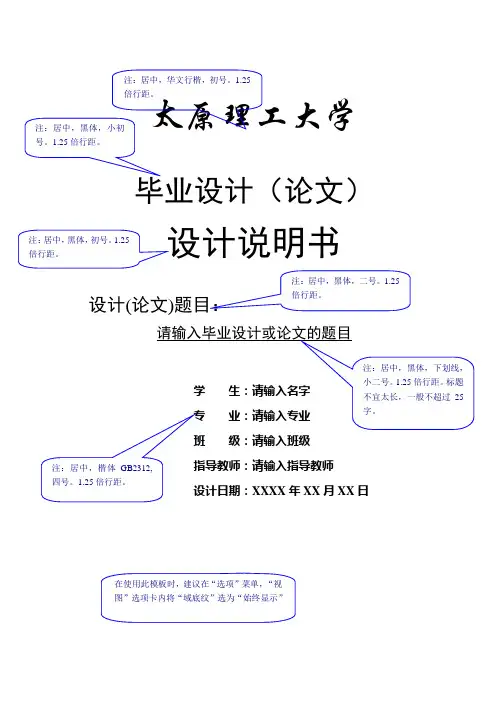
太原理工大学毕业设计(论文)设计说明书 设计(论文)题目:注:居中,黑体,小初号。
1.25倍行距。
注:居中,华文行楷,初号。
1.25倍行距。
注:居中,黑体,初号。
1.25倍行距。
注:居中,黑体,二号。
1.25倍行距。
在使用此模板时,建议在“选项”菜单,“视图”选项卡内将“域底纹”选为“始终显示”太原理工大学毕业设计(论文)任务书第2页摘 要采用插入“分节符”——“下一页”类型,与前面的设计任务书相区别,便于页面编号。
本页的页码编号及英文摘要的编号采用罗马字符“Ⅰ、Ⅱ”的形式。
“摘要”是摘要部分的标题,不可省略。
标题“摘要”选用模板中的样式所定义的“标题1”,再居中;或者手动设置成字体:黑体,居中,字号:四号,单倍行距,段前、段后为0行。
摘要是毕业设计(论文)的缩影,文字要简练、明确。
内容要包括目的、方法、结果和结论。
单位采用国际标准计量单位制,除特别情况外,数字一律用阿拉伯数码。
文中不允许出现插图。
重要的表格可以写入。
摘要正文选用模板中的样式所定义的“正文”,每段落首行缩进2个汉字;或者手动设置成每段落首行缩进2个汉字,字体:宋体,字号:小四,行距:单倍行距,间距:段前、段后均为0行,取消网格对齐选项。
摘要篇幅以一页为限,字数为300字左右。
摘要正文后,列出3-5个关键词。
“关键词:”是关键词部分的引导,不可省略。
关键词请尽量用《汉语主题词表》等词表提供的规范词。
关键词与摘要之间空一行。
关键词词间用分号间隔,末尾不加标点,3-5个;黑体,小四,加粗。
注:论文英文题目。
三号,Times New Roman,居中对齐,单倍行距,注意单词首字母大写阅后删除此文本框。
Please Input English TitleBased on the measurement data of Nanfeng District of Wuyang Coal Mine, Luan Coal Mining Administration, the gas emission forecast method of the initial velocity with the initial velocity method is introduced, and the application of this method has important practical significance of working out the plan and further prevention and control of mine gas.Key words: key word 1; key word 2;key word 2; key word 4外文摘要要求用英文书写,内容应与“中文摘要”对应。
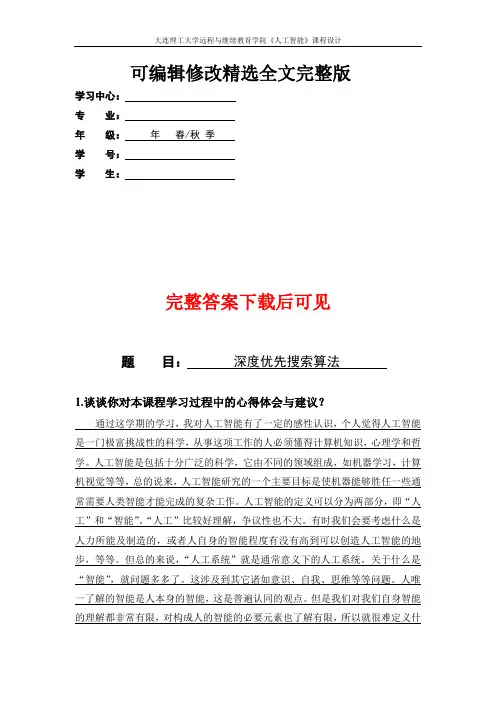
可编辑修改精选全文完整版学习中心:专业:年级:年春/秋季学号:学生:完整答案下载后可见题目:深度优先搜索算法1.谈谈你对本课程学习过程中的心得体会与建议?通过这学期的学习,我对人工智能有了一定的感性认识,个人觉得人工智能是一门极富挑战性的科学,从事这项工作的人必须懂得计算机知识,心理学和哲学。
人工智能是包括十分广泛的科学,它由不同的领域组成,如机器学习,计算机视觉等等,总的说来,人工智能研究的一个主要目标是使机器能够胜任一些通常需要人类智能才能完成的复杂工作。
人工智能的定义可以分为两部分,即“人工”和“智能”。
“人工”比较好理解,争议性也不大。
有时我们会要考虑什么是人力所能及制造的,或者人自身的智能程度有没有高到可以创造人工智能的地步,等等。
但总的来说,“人工系统”就是通常意义下的人工系统。
关于什么是“智能”,就问题多多了。
这涉及到其它诸如意识、自我、思维等等问题。
人唯一了解的智能是人本身的智能,这是普遍认同的观点。
但是我们对我们自身智能的理解都非常有限,对构成人的智能的必要元素也了解有限,所以就很难定义什么是“人工”制造的“智能”了。
关于人工智能一个大家比较容易接受的定义是这样的:人工智能是人造的智能是计算机科学、逻辑学、认知科学交叉形成的一门科学,简称AI。
人类正向信息化的时代迈进,信息化是当前时代的主旋律。
信息抽象结晶为知识,知识构成智能的基础。
因此,信息化到知识化再到智能化,必将成为人类社会发展的趋势。
人工智能已经并且广泛而有深入的结合到科学技术的各门学科和社会的各个领域中,她的概念,方法和技术正在各行各业广泛渗透。
而在我们的身边,智能化的例子也屡见不鲜。
在军事、工业和医学等领域中人工智能的应用已经显示出了它具有明显的经济效益潜力,和提升人们生活水平的最大便利性和先进性。
2.《人工智能》课程设计,从以下5个题目中任选其一作答。
《人工智能》课程设计题目三:深度优先搜索算法要求:(1)撰写一份word文档,里面包括(算法思路、算法程序框图、主要函数代码)章节。
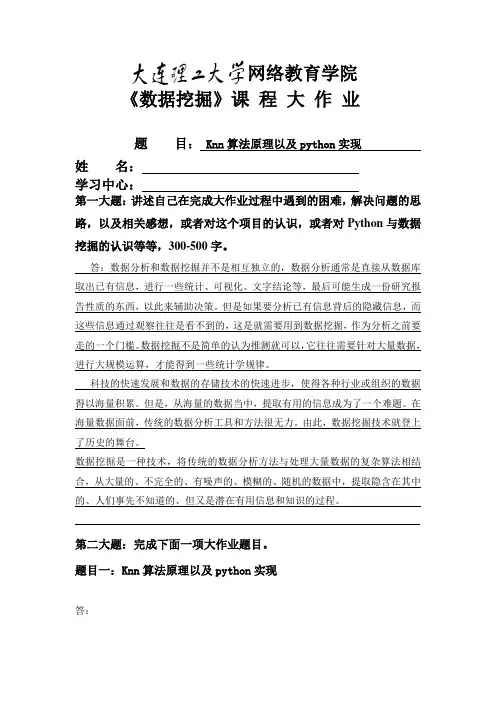
网络教育学院《数据挖掘》课程大作业题目:Knn算法原理以及python实现姓名:学习中心:第一大题:讲述自己在完成大作业过程中遇到的困难,解决问题的思路,以及相关感想,或者对这个项目的认识,或者对Python与数据挖掘的认识等等,300-500字。
答:数据分析和数据挖掘并不是相互独立的,数据分析通常是直接从数据库取出已有信息,进行一些统计、可视化、文字结论等,最后可能生成一份研究报告性质的东西,以此来辅助决策。
但是如果要分析已有信息背后的隐藏信息,而这些信息通过观察往往是看不到的,这是就需要用到数据挖掘,作为分析之前要走的一个门槛。
数据挖掘不是简单的认为推测就可以,它往往需要针对大量数据,进行大规模运算,才能得到一些统计学规律。
科技的快速发展和数据的存储技术的快速进步,使得各种行业或组织的数据得以海量积累。
但是,从海量的数据当中,提取有用的信息成为了一个难题。
在海量数据面前,传统的数据分析工具和方法很无力。
由此,数据挖掘技术就登上了历史的舞台。
数据挖掘是一种技术,将传统的数据分析方法与处理大量数据的复杂算法相结合,从大量的、不完全的、有噪声的、模糊的、随机的数据中,提取隐含在其中的、人们事先不知道的、但又是潜在有用信息和知识的过程。
第二大题:完成下面一项大作业题目。
题目一:Knn算法原理以及python实现答:一、knn算法介绍邻近算法,或者说K最近邻(kNN, k-NearestNeighbor)分类算法是数据挖掘分类技术中最简单的方法之一。
所谓K最近邻,就是k个最近的邻居的意思,说的是每个样本都可以用它最接近的 k个邻居来代表。
kNN算法的核心思想是如果一个样本在特征空间中的k个最相邻的样本中的大多数属于某一个类别,则该样本也属于这个类别,并具有这个类别上样本的特性。
该方法在确定分类决策上只依据最邻近的一个或者几个样本的类别来决定待分样本所属的类别。
在类别决策时,只与极少量的相邻样本有关。
由于kNN方法主要靠周围有限的邻近的样本,而不是靠判别类域的方法来确定所属类别的,因此对于类域的交叉或重叠较多的待分样本集来说,kNN方法较其他方法更为适合。
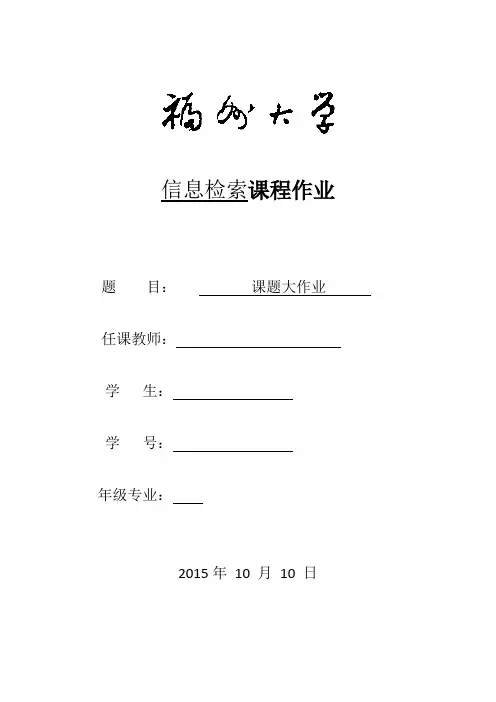
信息检索课程作业题目:课题大作业任课教师:学生:学号:年级专业:2015年10 月10 日成绩:评语:任课教师:(签名)1 课题的分析1.1 你的课题涉及到的主要概念进行分析(推荐使用思维导图)。
要求:要有主概念面、相关概念、隐含概念、英文检索词1.2 写出拟进行检索的检索策略、涉及到的学科范围。
检索策略:主题=“智能物流or第三方物流”*设计学科范围:如计算机软件及计算机应用,宏观经济管理可持续发展等1.3 总体检索思路你目前对这个课题了解的大致情况,以及你希望解决的问题。
由此你准备如何展开(国内、国外、年限、文献类型)。
智能物流以前有所涉及,但不够深入,系统学习第三方物流,智能物流是利用集成智能化技术,使物流系统能模仿人的智能,具有思维,感知,学习,推理判断和自行解决物流中某些问题的能力。
智能物流的发展会更加突出“以顾客为中心”的理念,但现在很多企业智能化不高,不够重视。
我想分析智能物流对第三方物流的影响,并加以具体物流企业案例分析,提出建议,改善管理。
首先是论文的搜集与整理,由于此课题暂时研究人不多,所以要参考期刊和新闻等。
会集中在国内的文献上。
鉴于期刊数字的有限,我想我会更多的参考学术论文;观点新颖与明确,逻辑清晰,可以引导我的立意。
2搜索引擎(百度、谷歌)2.1检索策略智能物流and第三方物流2.2找到的结果(截图第一页)2.3你选定的最相关的结果(要求必须可直接看原文)选择第三篇文章“第三方智能物流系统”点击下载全文,下载完毕后,就可以直接查看原文2.4说明选择该文的原因,从中你是否有新的想法(线索)原因:1:智能是导师分配研究的一个课题,第三方物流与智能物流是未来的发展前景,从而第三方物流行业内本身也面临激烈的竞争,使得第三方物流继续寻求物流系统内资源整合和优化,从而使得企业在追求物流智能化上存在强烈的内在驱动力。
2:本文对物联网及物流配送的介绍足够详细,关键是其对第三方物流系统总体框架的设计足够有说服力和可参考性。
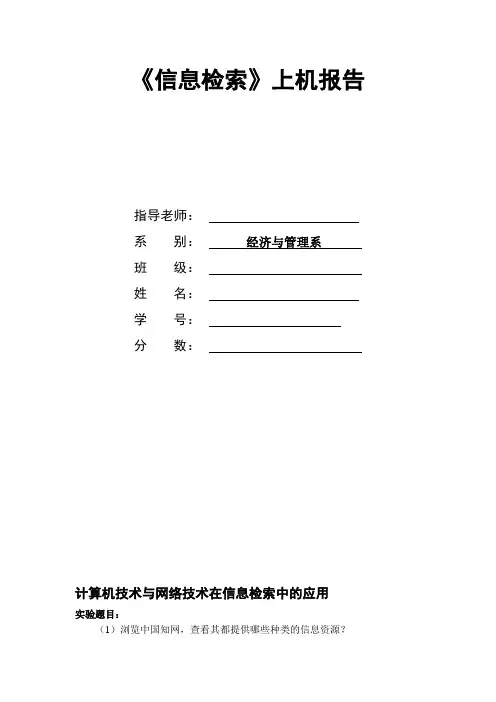
《信息检索》上机报告指导老师:系别:经济与管理系班级:姓名:学号:分数:计算机技术与网络技术在信息检索中的应用实验题目:(1)浏览中国知网,查看其都提供哪些种类的信息资源?(2)自己选择一个检索词,如“物流配送”“电子商务”“竞争情报”“工程材料”等,分别利用“模糊匹配”“精确匹配”等各种匹配方式,检索相关论文(期刊论文或者硕博士论文),并输出检索结果(截图),记下检索结果数量(篇数)。
(要求分别尝试:简单检索、高级检索、专业检索、多库检索、二次检索,分类检索等,提供至少4种检索方式)。
(3)利用中国知网的知识元搜索功能,自选主题,完成2种检索任务。
(4)利用百度搜索引擎,完成某一主题的精确搜索、消除无关搜索、并行搜索、特定站点搜索、特定类型文件搜索等检索任务(自选至少5种搜索方式)。
实验结果:(1)文献、期刊(商业评论期刊_特刊)、博硕士(博士、硕士)、会议(国内会议国际会议)、报纸、年鉴、统计数据、工具书(百科词典手册)、指数、专利(中国专利海外专利)、标准(国家标准全文、行业标准全文、国内外标准题录)、成果、法律、图片、古籍、引文、学术辑刊、高等教育、精品科普、精品文化、精品文艺作品、党建期刊、经济信息、政报公报。
截图如下:(2)1.简单检索登陆中国知网主页-期刊-主题检索,进入简单检索状态,输入主题词为“物流外包”点击检索得到的检索结果数目为2252篇。
2.高级检索登陆中国知网主页-期刊-主题检索,进入高级检索状态,输入主题词为“子物流外包”选择“模糊匹配”得到的检索结果数目为213篇。
登陆中国知网主页-期刊-主题检索,进入高级检索状态,输入主题词为“物流外包”选择“精确匹配”得到的检索结果数目为337篇3.专业检索登陆中国知网主页-期刊-主题检索,进入高级检索状态,输入检索字段SU=物流外包,主题词为“物流外包”选择发表时间从1991年到2013得到的检索结果数目为2035篇4.句子检索登陆中国知网主页-期刊-主题检索,进入高级检索状态,选择句子检索,在全文选“同一段”输入“物流外包风险管理”和“风险控制策略研究”,主的文章得到的检索结果数目为1篇(三)利用中国知网的知识元搜索功能,自选主题,完成2种检索任务。
第一章第二章作业1、利用书目查询的多字段检索模式,检索我馆收录2014年(含2014年)以后出版电子工业出版社出版的计算机方面相关图书有多少种?请写出所用检索词和检索项,并写出其中两本图书的书名、作者、出版社、索书号。
检索词:计算机检索项:结果排序:出版日期,降序;选择校区:总馆202种计算机英语教程.第六版作者:司爱侠、张强华出版社:电子工业出版社索书号:H31-43/38=3UMI面向对象系统分析与设计教程作者:胡志喜等出版社:电子工业出版社索书号:TP312/52042、请问本馆是否收藏张卫平写的“开关变换器”方面的中文图书,若收藏,其书名、索书号和馆藏地分别是什么?开关变换器的建模与控制索书号:TN624/3馆藏地:总馆—书库13、请同学进入书目查询的“我的图书馆”模块,查看自己的借阅历史,共借过多少册书?想想如何实现对新书阅览室图书续借?如果想借的图书都被借走,如何在网上办理预约?从哪里可以得到预约到馆的信息?共借过7册;可以到图书馆的咨询台找老师办理或者通过上网在我的图书馆中进行续借;在北方工大图书馆的网上找到想要借阅的书,点进去后找到预约申请;在我的图书馆中的我的预约可以得到预约到馆的信息。
4、利用自建电子资源模块中的金榜题名库,检索我校2013年考取研究生的数量?同时检索出你所在学院的研究生考取数量,并列出其中2所不同学校的名称。
我校2013年考取研究生的数量为299人;我所在学院的研究生考取数量69人;韩圣东中国科学研究院电子与通信工程;蔡宇晶中国铁道科学研究院计算机技术;5、请把以下图书的索书号按本馆排架的顺序排列TP317/36 TP39/45 TP303/115 TP27/3 TP319/78 TP31/789 H319.9/12 TP3/29H319.9/12 TP3/29 TP27/3 TP31/789 TP39/45 TP303/115 TP317/36 TP319/786、请写出中图法中你常用的6个大类的名称,若是工业技术方面的内容,请具体写出他的两个字母的名称,如:H 语言文字TP自动化技术、计算机技术TP3计算技术、计算机技术H语言、文字O数理科学与化学R医药、卫生Z综合性图书7、请拷贝读者条例中“读者借阅须知”的内容读者条例读者入馆须知1.读者凭我校一卡通入馆。
信息检索综合报告一、中文数据库检索检索课题:中国武术散打(学生自拟或教师给出)检索工具:万方数据知识服务平台(学生自选或指定)课题重点、关键词、主题词等分析(中英文): 中国,武术,散打,发展(学生自己分析)检索步骤:1、分析研究课题,确定检索词(检索词不少于2个),用布尔逻辑算符,制定出相应的检索式。
检索词1 中国 检索词2 武术 检索词3 散打 检索词4检索式① 中国武术散打 检索式②中国武术—散打2、选择检索限定范围。
查询(学科)范围 全部 检索年限范围 不限 检索(期刊)范围全部3、选择检索字段,根据检索方式输入检索词或检索式,进行检索。
(1)初次检索:输入检索词进行检索。
(根据实检的情况填写检索结果,并将检索过程进行截屏!) 在此插入截屏图)检索词 检索字段(也可选其它字段) 检索结果(篇数) 中国武术标题1417在上次检索的基础上进行二次检索(最后命中篇数10-300之间):检索词 检索字段 逻辑运算符组配检索后 命中文献篇数中国武术,散打标题与1614、记录较切题的2篇文献的篇名及文献出处如下;(1)篇名:中国武术散打发展研究文献出处:[期刊论文] 《新乡学院学报(自然科学版)》-2011年2期赵连保,ZHAO Lian-bao(2)篇名:中国武术散打现状与发展对策文献出处:[期刊论文] 《攀枝花学院学报》-2010年6期丁德熙,张启迪,Ding De-xi,Zhang Qi-di5、选中其中切题文献1篇,点击篇名,显示其题录信息如下;篇名中国武术散打发展研究作者赵连保关键词中国,武术,散发,发展文献出处新乡学院学报(自然科学版)二、特种文献检索注:每一步骤都要进行抓图1.中文学位论文选择中国知网数字出版平台——中国优秀硕士学位论文全文数据库、中国博士学位论文全文数据库、国家科技图书文献中心——中文学位论文等数据库中的一种数据库进行学位论文检索。
数据库名称___中国优秀硕士学位论文全文数据库检索专业方向_______园林_______________________________检索词_________园林_____________________________检索年限___________不限____________________________检索策略(表达式)________与________________________命中文献数______6608______选取其中1条文献题录:论文题目:苏州私家园林造园思想与艺术风格初探作者姓名:陈涛吉导师姓名:刘凤君授予学位级别:硕士作者专业名称:艺术学学位授予单位:山东大学授予学位时间:2007论文总页数:外网,看不了,只有摘要,还不知道!2.会议论文选择中国知网数字出版平台——中国重要会议论文全文数据库、国家科技图书文献中心——中文会议论文等数据库中的1种数据库进行会议论文检索:数据库名称____中国重要会议论文全文数据库、检索专业方向_____园林_________________________________检索词___________园林___________________________检索年限_________不限______________________________检索策略(表达式)_______与_________________________命中文献数____3044________选取其中1条文献题录:论文题目:城郊观光农业型园林发展中的问题及策略作者姓名:周复合陈红安第一作者单位:河南省豫建市政园林工程有限公司会议名称:不详会议地点:不详主办单位:不详出处(会议录名称、出版时间、论文在会议录中的页码范围):【会议录名称】土木建筑学术文库(第15卷)【会议时间】2011-08-01【分类号】F5923.专利文献检索选择中国知网数字出版平台——中国专利全文数据库、中华人民共和国国家知识产权局——专利高级检索、国家科技图书文献中心——专利检索等数据库中的1种数据库进行专利检索:数据库名称__中国专利全文数据库__检索专业方向____园林__________________________________检索词__________园林____________________________检索年限_________不限______________________________检索策略(表达式)_________与_______________________命中文献数_______137_____专利名称:电动园林吹风机专利类型:发明专利申请(专利)号:CN200630103551.7申请(专利权)人:嘉善宝狮电子有限公司发明(设计)人:薛德祥公开(告)日:2006-12-13公开(告)号:CN3588902分类号:15-03说明书页数:64.标准文献选择——标准检索、标准网——标准目录高级查询等数据库中的1种数据库进行标准检索:数据库名称________国家科技图书文献中心___检索专业方向_________园林农业方向____________检索词_______________园林______________________检索年限_____________不限__________________________检索策略(表达式)________与________________________命中文献数_____16_______选取其中1条文献题录:标准名称:Lawn and garden ride-on (riding) tractors; three-point hitch标准编号:ISO 9191-1991起草单位或起草人:ISO/TC 23实施日期:发布日期:1991-03分类号:Q87;T61标准文献页数:6P.;A4三、网络文献检索注:每一步骤都要进行抓图(1)利用搜索引擎检索文献线索检索课题 __检索有关网络技术应用的文献________________________搜索引擎名称__百度()___________________________检索年限 __不限___________________________检索策略(表达式)__ site:() 有关网络技术应用的文献(应用)______________________命中文献数__ 79846 __________选取其中1条文献题录:文献题名:浅谈网络计划技术及其在生产中应用作者姓名:程宁宁文献类型:出处(出版物名称、年、卷、期或出版年、出版社):移动电源与车辆 2010年第1期被引用次数:3(2)利用网上免费资源检索文献检索课题 __有关园林设计的文献 ________________________网上免费资源名称__ 国家科技图书文献中心( ) _____________________检索年限 __2008-2011____________________________检索策略(表达式)__(关键词=园林)_and(关键词=设计)_____________________命中文献数__1290__________选取其中1条文献题录:文献题名:论中国元素在园林景观设计中的运用作者姓名:吴汛出处(出版物名称、年、卷、期、页码范围):刊名:《文学与艺术》出版年:2011卷:000期:001参考文献数:2四、本专业网上免费期刊(写出刊名、刊号和出版社,至少4种)《广东园林》国内刊号:CN44-1219/S 出版社:广东园林学会《现代园艺》国内统一刊号:CN 36-1287/S上海科学技术出版社《北京园林》出版社:北京市园林局《中国风景园林》中国建筑工业出版社五、本专业重要期刊目录(写出刊名、刊号和出版社,至少4种)《风景园林》国内统一刊号:CN11-5366/S 出版社:风景园林《中国园林》国内统一刊号:CN11-2165/TU 出版社:中国园林《景观设计》大连理工大学出版社《园林》出版社:上海市园林科学研究所六、校图书馆收藏的本专业期刊(写出刊名、刊号和出版社,至少3种)《中国园林》国内统一刊号:CN11-2165/TU 出版社:中国园林《风景园林》国内统一刊号:CN11-5366/S 出版社:风景园林《广东园林》国内刊号:CN44-1219/S 出版社:广东园林学会说明1、检索年限:近5年的有关文献。
《信息资源(文献)检索与利用》课外作业作业要求:书面作业,书写或打印均可,不收电子版,不收复印件资源与环境学院班别:姓名:学号:一. 名词解释(每题2.5分,共10分)1.文献国际标准对文献的解析是在存储、检索、利用或传递记录信息的过程中,可作为一个单元处理的,在载体内、载体上或依附载体而存有信息或数据的载体。
中华人民共和国国家标准对文献的的定义为文献是记录知识的一切载体。
2.信息资源可供利用并产生效益与社会生存和生活有关的各种文字、数字、音像、图表、语言等一切信息的总称3.参考工具书工具书是专供翻检查阅的图书。
它是广泛收集某一范围的知识材料,按照一定的方法加以编排,供解决疑难问题或提供资料线索的一种图书。
4.年鉴年鉴是系统汇集一年内重要时事文献、学科进展与各项统计资料,供人们查阅的工具书。
二.简述题(每题5分,共15分)1.结合自身体会,谈谈文献检索课在信息素养教育中的作用。
答:做为当代大学生的我们,自身所能掌握的知识总是有限的,我们必须学会怎么去寻找和获取知识,在这高速发展与信息不断更新的社会里,我们只有学会怎么样去获取有用的知识并且加以利用,我们才能跟上社会发展的步伐。
信息数据教育是整个素质教育体系中的一个组成部分,是根据社会信息环境,培养和提高个人的信息意识、信息能力,完美的信息心理素质,发展个人的信息潜能的一种教育活动。
信息素质教育主要包括信息知识教育、信息知识能力教育及信息伦理道德教育等四个方面,有信息素养不仅能使学习者更好地掌握学习内容,拓展研究范围,增长知识,还能进行自我导向学习。
所以学习文献检索课对我们现在与将来的学习十分重要的作用。
2.举例说明信息、知识、情报和文献的联系和区别。
答:信息为最大的主体,它可以包括全部,文献是信息、知识、情报的主要载体形式。
情报包括信息和知识的特征,是被活化了的、能解决特定问题的那一部分知识。
知识源于信息,是经加工提炼了的那一部分信息。
它们之间有外延与内涵的关系,总的来说没有什么特别的界限,可以说它们相互包涵。
重庆科技学院学生实验报告(二)一、实践目的和要求1. 通过网上查阅资料了解一些计算机检索和文献检索的基础知识和概念。
2. 通过使用一些基本检索技术进行检索训练。
3. 通过网上查阅资料了解一些互联网资源的基础知识和概念。
4. 通过使用一些基本检索技术进行互联网资源检索训练。
3. 实践报告打印,实践结束后,及时整理出实习报告提交。
二、实践前的预习内容计算机以及网络资源的检索和文献检索的基础知识和概念、基本检索技术三、主要设备互联网计算机四、实践内容1. 在百度百科中查阅有关于“综述”的百科名片,并记录其网址和含义。
检索结果:/view/675725.htm综述是指就某一时间内,作者针对某一专题,对大量原始研究论文中的数据、资料和主要观点进行归纳整理、分析提炼而写成的论文。
综述属三次文献,专题性强,涉及范围较小,具有一定的深度和时间性,能反映出这一专题的历史背景、研究现状和发展趋势,具有较高的情报学价值。
阅读综述,可在较短时间内了解该专题的最新研究动态,可以了解若干篇有关该专题的原始研究论文。
国内外大多数医学期刊都辟有综述栏目。
2. 网络上登录维基百科和百度百科,分别各自找寻一个互不相同的词条并记录下来其定义和网址。
检索结果:/view/203980.htm文献综述,是指就某一时间内,作者针对某一专题,对大量原始研究论文中的数据、资料和主要观点进行归纳整理、分析提炼而写成的论文。
综述属三次文献,专题性强,涉及范围较小,具有一定的深度和时间性,能反映出这一专题的历史背景、研究现状和发展趋势,具有较高的情报学价值。
/wiki/%E4%BA%BA人(学名:智人、Homo sapiens,意为“有智慧的人”),是一种灵长目人科人属及直立行走的物种。
[3][4]粒线体DNA 与化石证明人类大约于500万年前起源于东非。
与其他动物相比,人具有高度发达的大脑,具有抽象思维、语言、自我意识以及解决问题的能力。
此种能力,加之人类直立的身体导致人类的前肢可以自由活动,使得人类对工具的使用远超出其它任何物种。
学院:专业:班级:学号:姓名:上机大作业1:1.最速下降法:function f = fun(x)f = (1-x(1))^2 + 100*(x(2)-x(1)^2)^2; endfunction g = grad(x)g = zeros(2,1);g(1)=2*(x(1)-1)+400*x(1)*(x(1)^2-x(2)); g(2) = 200*(x(2)-x(1)^2);endfunction x_star = steepest(x0,eps) gk = grad(x0);res = norm(gk);k = 0;while res > eps && k<=1000dk = -gk;ak =1; f0 = fun(x0);f1 = fun(x0+ak*dk);slope = dot(gk,dk);while f1 > f0 + *ak*slopeak = ak/4;xk = x0 + ak*dk;f1 = fun(xk);endk = k+1;x0 = xk;gk = grad(xk);res = norm(gk);fprintf('--The %d-th iter, the residual is %f\n',k,res); endx_star = xk;end>> clear>> x0=[0,0]';>> eps=1e-4;>> x=steepest(x0,eps)2.牛顿法:function f = fun(x)f = (1-x(1))^2 + 100*(x(2)-x(1)^2)^2; endfunction g = grad2(x)g = zeros(2,2);g(1,1)=2+400*(3*x(1)^2-x(2));g(1,2)=-400*x(1);g(2,1)=-400*x(1);g(2,2)=200;endfunction g = grad(x)g = zeros(2,1);g(1)=2*(x(1)-1)+400*x(1)*(x(1)^2-x(2)); g(2) = 200*(x(2)-x(1)^2);endfunction x_star = newton(x0,eps)gk = grad(x0);bk = [grad2(x0)]^(-1);res = norm(gk);k = 0;while res > eps && k<=1000dk=-bk*gk;xk=x0+dk;k = k+1;x0 = xk;gk = grad(xk);bk = [grad2(xk)]^(-1);res = norm(gk);fprintf('--The %d-th iter, the residual is %f\n',k,res); endx_star = xk;end>> clear>> x0=[0,0]';>> eps=1e-4;>> x1=newton(x0,eps)--The 1-th iter, the residual is--The 2-th iter, the residual isx1 =法:function f = fun(x)f = (1-x(1))^2 + 100*(x(2)-x(1)^2)^2; endfunction g = grad(x)g = zeros(2,1);g(1)=2*(x(1)-1)+400*x(1)*(x(1)^2-x(2)); g(2) = 200*(x(2)-x(1)^2);endfunction x_star = bfgs(x0,eps) g0 = grad(x0);gk=g0;res = norm(gk);Hk=eye(2);k = 0;while res > eps && k<=1000dk = -Hk*gk;ak =1; f0 = fun(x0);f1 = fun(x0+ak*dk);slope = dot(gk,dk);while f1 > f0 + *ak*slopeak = ak/4;xk = x0 + ak*dk;f1 = fun(xk);endk = k+1;fa0=xk-x0;x0 = xk;go=gk;gk = grad(xk);y0=gk-g0;Hk=((eye(2)-fa0*(y0)')/((fa0)'*(y0)))*((eye(2)-(y0)*(fa0)')/((fa0)'*(y0)))+(fa0*(fa 0)')/((fa0)'*(y0));res = norm(gk);fprintf('--The %d-th iter, the residual is %f\n',k,res);endx_star = xk;End>> clear>> x0=[0,0]';>> eps=1e-4;>> x=bfgs(x0,eps)4.共轭梯度法:function f = fun(x)f = (1-x(1))^2 + 100*(x(2)-x(1)^2)^2; endfunction g = grad(x)g = zeros(2,1);g(1)=2*(x(1)-1)+400*x(1)*(x(1)^2-x(2)); g(2) = 200*(x(2)-x(1)^2);endfunction x_star =CG(x0,eps) gk = grad(x0);res = norm(gk);k = 0;dk = -gk;while res > eps && k<=1000 ak =1; f0 = fun(x0);f1 = fun(x0+ak*dk);slope = dot(gk,dk);while f1 > f0 + *ak*slope ak = ak/4;xk = x0 + ak*dk;f1 = fun(xk);endk = k+1;x0 = xk;g0=gk;gk = grad(xk);res = norm(gk);p=(gk/g0)^2;dk1=dk;dk=-gk+p*dk1;fprintf('--The %d-th iter, the residual is %f\n',k,res); endx_star = xk;end>> clear>> x0=[0,0]';>> eps=1e-4;>> x=CG(x0,eps)上机大作业2:function f= obj(x)f=4*x(1)-x(2)^2-12;endfunction [h,g] =constrains(x) h=x(1)^2+x(2)^2-25;g=zeros(3,1);g(1)=-10*x(1)+x(1)^2-10*x(2)+x(2)^2+34;g(2)=-x(1);g(3)=-x(2);endfunction f=alobj(x) %拉格朗日增广函数%N_equ等式约束个数?%N_inequ不等式约束个数N_equ=1;N_inequ=3;global r_al pena;%全局变量h_equ=0;h_inequ=0;[h,g]=constrains(x);%等式约束部分?for i=1:N_equh_equ=h_equ+h(i)*r_al(i)+(pena/2)*h(i).^2;end%不等式约束部分for i=1:N_inequh_inequ=h_inequ+pena)*(max(0,(r_al(i)+pena*g(i))).^2-r_al(i).^2); end%拉格朗日增广函数值f=obj(x)+h_equ+h_inequ;function f=compare(x)global r_al pena N_equ N_inequ;N_equ=1;N_inequ=3;h_inequ=zeros(3,1);[h,g]=constrains(x);%等式部分for i=1:1h_equ=abs(h(i));end%不等式部分for i=1:3h_inequ=abs(max(g(i),-r_al(i+1)/pena));endh1 = max(h_inequ);f= max(abs(h_equ),h1); %sqrt(h_equ+h_inequ);function [ x,fmin,k] =almain(x_al)%本程序为拉格朗日乘子算法示例算法%函数输入:% x_al:初始迭代点% r_al:初始拉格朗日乘子N-equ:等式约束个数N_inequ:不等式约束个数?%函数输出% X:最优函数点FVAL:最优函数值%============================程序开始================================ global r_al pena ; %参数(全局变量)pena=10; %惩罚系数r_al=[1,1,1,1];c_scale=2; %乘法系数乘数cta=; %下降标准系数e_al=1e-4; %误差控制范围max_itera=25;out_itera=1; %迭代次数%===========================算法迭代开始============================= while out_itera<max_iterax_al0=x_al;r_al0=r_al;%判断函数?compareFlag=compare(x_al0);%无约束的拟牛顿法BFGS[X,fmin]=fminunc(@alobj,x_al0);x_al=X; %得到新迭代点%判断停止条件?if compare(x_al)<e_aldisp('we get the opt point');breakend%c判断函数下降度?if compare(x_al)<cta*compareFlagpena=1*pena; %可以根据需要修改惩罚系数变量elsepena=min(1000,c_scale*pena); %%乘法系数最大1000disp('pena=2*pena');end%%?更新拉格朗日乘子[h,g]=constrains(x_al);for i=1:1%%等式约束部分r_al(i)= r_al0(i)+pena*h(i);endfor i=1:3%%不等式约束部分r_al(i+1)=max(0,(r_al0(i+1)+pena*g(i)));endout_itera=out_itera+1;end%+++++++++++++++++++++++++++迭代结束+++++++++++++++++++++++++++++++++ disp('the iteration number');k=out_itera;disp('the value of constrains'); compare(x_al)disp('the opt point');x=x_al;fmin=obj(X);>> clear>> x_al=[0,0];>> [x,fmin,k]=almain(x_al)上机大作业3: 1、>> clear alln=3; c=[-3,-1,-3]'; A=[2,1,1;1,2,3;2,2,1;-1,0,0;0,-1,0;0,0,-1];b=[2,5,6,0,0,0]';cvx_beginvariable x(n)minimize( c'*x)subject toA*x<=bcvx_endCalling SDPT3 : 6 variables, 3 equality constraints------------------------------------------------------------num. of constraints = 3dim. of linear var = 6*******************************************************************SDPT3: Infeasible path-following algorithms*******************************************************************version predcorr gam expon scale_dataNT 1 1 0it pstep dstep pinfeas dinfeas gap prim-obj dual-obj cputime -------------------------------------------------------------------0|||+01|+00|+02|+01 +00| 0:0:00| chol 1 11|||||+01|+00 +01| 0:0:01| chol 1 12|||||+00|+00 +01| 0:0:01| chol 1 13|||||+00|+00 +00| 0:0:01| chol 1 14||||||+00 +00| 0:0:01| chol 1 15||||||+00 +00| 0:0:01| chol 1 16||||||+00 +00| 0:0:01| chol 1 17||||||+00 +00| 0:0:01| chol 1 18||||||+00 +00| 0:0:01|stop: max(relative gap, infeasibilities) <------------------------------------------------------------------- number of iterations = 8primal objective value = +00dual objective value = +00gap := trace(XZ) =relative gap =actual relative gap =rel. primal infeas (scaled problem) =rel. dual " " " =rel. primal infeas (unscaled problem) = +00rel. dual " " " = +00norm(X), norm(y), norm(Z) = +00, +00, +00norm(A), norm(b), norm(C) = +00, +00, +00Total CPU time (secs) =CPU time per iteration =termination code = 0DIMACS: +00 +00-------------------------------------------------------------------------------------------------------------------------------Status: SolvedOptimal value (cvx_optval):2、>> clear alln=2; c=[-2,-4]'; G=[,0;0,1]; A=[1,1;-1,0;0,-1]; b=[1,0,0]'; cvx_beginvariable x(n)minimize( x'*G*x+c'*x)subject toA*x<=bcvx_endCalling SDPT3 : 7 variables, 3 equality constraintsFor improved efficiency, SDPT3 is solving the dual problem.------------------------------------------------------------num. of constraints = 3dim. of socp var = 4, num. of socp blk = 1dim. of linear var = 3*******************************************************************SDPT3: Infeasible path-following algorithms*******************************************************************version predcorr gam expon scale_dataNT 1 1 0it pstep dstep pinfeas dinfeas gap prim-obj dual-obj cputime -------------------------------------------------------------------0||||+00|+02| +01 +00| 0:0:00| chol 1 11|||||+01| +00 | 0:0:00| chol 1 12|||||+00| +00 | 0:0:00| chol 1 13|||||| | 0:0:00| chol 1 14|||||| | 0:0:00| chol 1 15|||||| | 0:0:00| chol 1 16|||||| | 0:0:00| chol 1 17|||||| | 0:0:00| chol 1 18|||||| | 0:0:00| chol 1 19|||||| | 0:0:00| chol 1 110|||||| | 0:0:00| chol 2 211|||||| | 0:0:00| chol 2 212|||||| | 0:0:00| chol 2 213|||||| | 0:0:00| chol 2 214|||||| | 0:0:00|stop: max(relative gap, infeasibilities) <------------------------------------------------------------------- number of iterations = 14primal objective value =dual objective value =gap := trace(XZ) =relative gap =actual relative gap =rel. primal infeas (scaled problem) =rel. dual " " " =rel. primal infeas (unscaled problem) = +00rel. dual " " " = +00norm(X), norm(y), norm(Z) = +00, +00, +00norm(A), norm(b), norm(C) = +00, +00, +00Total CPU time (secs) =CPU time per iteration =termination code = 0DIMACS: +00 +00-------------------------------------------------------------------------------------------------------------------------------Status: SolvedOptimal value (cvx_optval): -3。
信息检索课作业
姓名李彤
学号31709068
院系信息与通信工程学院
专业电子与通信工程
完成时间: 2017年 11月
人工挖孔灌注桩施工方案
三、文献检索范围及结果
1.《中国期刊全文数据库》(CNKI中国知网)
2.《万方数据库》(万方数据知识服务平台)
3.Science Citation Index Expanded或Social Sciences Citation Index (SCI-E或SSCI)
4.EI Engineering Village:Compendex(EI)
5.Scopus:
6.The ProQuest Dissertations and Theses(B) (PQDT-B)
7.Conference Proceedings Citation Index-Science或 Conference Proceedings Citation Index - Social Science & Humanities (CPCI-S或CPCI-SSH)
8.Derwent Innovations Index
四、查询特定期刊的影响因子
选取检索结果中的文章《Deep Convolutional Neural Networks with transfer learning for computer vision-based data-driven pavement distress detection》发表的期刊Construction & Building Materials。
此期刊2016年的影响因子为3.169。
五.完成特定格式参考文献的标准著录
模拟文章:
Apollo program, Project Apollo
Apollo, Moon-landing project conducted by the U.S. National Aeronautics and Space
Administration in the 1960s and ’70s①[1]. The Apollo program was announced in May 1961, but the choice among competing techniques for achieving a Moon landing and return was not resolved until considerable further study. In the method ultimately employed, a powerful launch vehicle (Saturn V rocket) placed a 50-ton spacecraft in a lunar trajectory. Several Saturn launch vehicles and accompanying spacecraft were built. The Apollo spacecraft were supplied with rocket power of their own, which allowed them to brake on approach to the Moon and go into a lunar orbit. They also were able to release a component of the spacecraft, the Lunar Module (LM), carrying its own rocket power, to land two astronauts on the Moon and bring them back
to the lunar orbiting Apollo craft②[2].
The first manned Apollo flight was delayed by a tragic accident, a fire that broke out in the Apollo 1 spacecraft during a ground rehearsal on January 27, 1967, killing all three astronauts. On October 11, 1968, following several unmanned Earth-orbit flights, Apollo 7 made a 163-orbit flight carrying a full crew of three astronauts. Apollo 8 carried out the first step of manned lunar exploration; from Earthorbit it was injected into a lunar trajectory, completed lunar orbit, and returned safely to Earth. Apollo 9 carried out a prolonged mission in Earth orbit to check out the LM. Apollo 10 journeyed to lunar orbit and tested the LM to within 15.2 km (50,000 feet) of the Moon’s surface. Apollo 11, in July 1969, climaxed the step-by-step procedure with a lunar landing; on July 20 astronaut Neil Armstrong became the
first hu man to set foot on the Moon’s surface③[3].
按规定日期将作业发送到:(请用“信息检索2017+院系+姓名+学号”做文件名和邮件主题)
校对报告
当前使用的样式是 [中华人民共和国国家标准_GBT_7714-2005]
当前文档包含的题录共3条
有0条题录存在必填字段内容缺失的问题
所有题录的数据正常
参考文献
[1] 吉阳生, 陈家骏, 牛罡, et al. Transfer Learning via Multi-View Principal Component
Analysis[J]. Journal of Computer Science & Technology, 2011(01):81-98.
[2] 戴文渊. 基于实例和特征的迁移学习算法研究[D]. 上海交通大学, 2009.
[3] 庄福振, 罗平, 何清, 等. 迁移学习研究进展[J]. 软件学报, 2015(01):26-39.
页脚内容10。